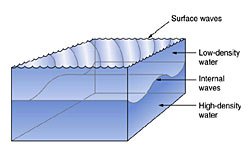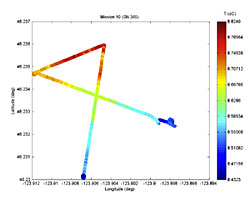You are here
Mobile Platforms Measure Internal Waves
06/02/09 Astoria, Ore.
CMOP scientists successfully launched its new autonomous underwater vehicles (AUV) to gain a better understanding of the Columbia River estuary and near plume system. The AUVs will intitally be used to study internal waves.
 Internal wave diagramWhile surface waves are generated mostly by wind, internal waves oscillate within the water due to the density stratification often generated by coastal tides. They cause local circulations to redistribute nutrients and minerals. Internal waves can also cause vertical velocity shear, which can intensify vertical mixing process and bring suspended particles and nutrients to the surface.
Internal wave diagramWhile surface waves are generated mostly by wind, internal waves oscillate within the water due to the density stratification often generated by coastal tides. They cause local circulations to redistribute nutrients and minerals. Internal waves can also cause vertical velocity shear, which can intensify vertical mixing process and bring suspended particles and nutrients to the surface.
Craig McNeil, oceanographer from the Applied Physics Laboratory at the University of Washington and CMOP investigator, is using AUV’s to study the generation and propagation of internal waves in the Columbia River estuary and plume. He is interested in the physics of internal waves and mixing near the sea surface and the sea floor.
“Scientists speculate that some bottom following internal waves have closed circulations that traps water and biology,” said McNeil. “The AUVs will help us sample these waves so we can better understand these complex mixing mechanisms.”
One upcoming experiment will study the dynamics of the freshwater plume as it spreads out over the denser saltwater of the coastal ocean. Of particular interest is to compare measured entrainment rates with theoretical predictions. McNeil will program the vehicles to travel into the advancing plume and navigate through the plume front. This will allow CMOP to study the progression of internal waves that are known to be generated at the advancing plume front and determine their propagation speed. 
![]() Watch Craig, Troy, and Trina deploy the AUV in the Columbia River.
Watch Craig, Troy, and Trina deploy the AUV in the Columbia River.
Before those measurements could take place, McNeil needed to test the vehicles’ capabilities in the field. Along with oceanographer Trina Litchendorf and field engineer Troy Swanson, McNeil tested the vehicle in Lake Washington over the winter months. By spring the team was ready to take it through its paces in the Columbia River estuary.
They traveled to Astoria, Oregon and met up with CMOP’s field team, including Michael Wilkin and Katie Rathmell, for the vehicle’s first mission in the river. It was determined the initial tests were conducted during slack tide due to the limits of the vehicle in strong currents. The mission was based on tidal cycle information supplied by CMOP’s cyber-team. The expected velocities during slack tide would be less than 0.5 m/s or about 1 knot, which was in the acceptable range for the vehicles.  This figure shows a map of water temperature recorded by the CTD on the AUV during its first mission in the North Channel of the Columbia River estuary westward of the Astoria Bridge.
This figure shows a map of water temperature recorded by the CTD on the AUV during its first mission in the North Channel of the Columbia River estuary westward of the Astoria Bridge.
The vehicle was deployed near the first transponder set by the team in the North Channel of the Columbia River. There it performed a compass calibration and proceeded to its first designated waypoint. To make sure it was on track, McNeil monitored the vehicle’s position with a device called the Ranger. The Ranger's transponder receives status updates from the vehicle.
The results of the mission were a success. The vehicle traveled upon its designated coordinates and collected salinity and temperature data. Now the team has a better understanding of how to navigate the vehicle in the river and will be able to perform longer missions.
McNeil and his team will now use the AUVs to study various physical processes in the Columbia River estuary, including internal waves, currents, and mixing.
View photos from the AUV deployment →
Written by Jeff Schilling






